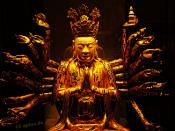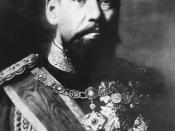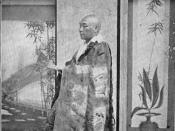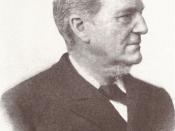Description: present a generalization about Japan that would usually seem to be accurate based on what you have learned, and then cite some counter-examples to the generalization.
Separation of Religions in Meiji JapanBefore the Meiji policy that authorized the separation of Shinto and Buddhism, Japanese religious culture had been to all intents defined by Buddhism. Shrines-based practices were nothing more than Buddhism's secular practices, and kami were understood to be manifestations of the Buddha (Lecture 2/20). Buddhism, which had been integral to Japanese culture for a long period of time, became the target of harsh persecution with the rise of the Meiji regime. Thousands of Buddhist temples were closed or destroyed, priests were forced out of their priesthoods, and texts and statues were burned (Lecture 3/8). Japanese people began attacking Buddhism as a drain on public resources, a foreign superstition that oppressed the indigenous Japanese spirit, and other mythic elements hindered the social progress (Lecture 3/8).
In general, people tended to characterize the persecution of Buddhism as a response to its institutional decadence, but in fact, the policy of separation of Shinto and Buddhism was part of a larger effort to separate religious and political spheres in an attempt to control religious institutions.
Prior to the Meiji period, Buddhism in Japan became more secular than it was before. Because the government required people to employ Buddhists for funeral rites, temple affiliation began to become part of a business. Out of this situation, temples became not only increasingly wealthy but also more exclusive places of interaction among members to the temples. The result of this development was that a priest has shifted from spiritual to economic. The institution of Buddhist temples became decadent to most people at that time (Tomatsu). Since Shinto had fused Buddhist worship for centuries, an effort to free Shinto from Buddhist domination triggered of violence and the breaking of images that committed against Buddhism.
In fact, the separation of Shinto and Buddhism was due to an effort of the Meiji government to gain control of religious and political spheres. During Meiji restoration, a new form of constitutional government, headed by the emperor, replaced the feudal rule of the shoguns. In order to emphasize civic duty and devotion to the emperor as a divinity, the Meiji rulers created State Shinto to adhere every Japanese citizen with this sense of constitutional duty. In line with government sponsorship and funding of State Shinto, the Meiji government implemented anti-Buddhist strategies on the Buddhist monasteries. The Meiji government proceeded to break up the Buddhist estates, and forced the powerful temples to cut their Shinto ties. This caused the popular sentiment that turned against Buddhism with which portrayed it as a foreign cult of corruption and decadence. The Meiji government also issued a compulsory registration for people at Shinto shrines, in turn to replacing the Tokugawa system of registration at Buddhist temples. The government promulgated of an official festival calendar, and tried to link shrine organization and kami worship to government authority (Lecture 3/8).
The Meiji government systematically brought Shinto and Buddhism under official control. The notion of Shinto as Japan's indigenous religion finally emerged complete with the rise of modern nationalism, which evolved from the National Learning and the establishment of State Shinto in the Meiji period (Gluck 7). The Meiji separation of Shinto and Buddhism and its concomitant suppression of Buddhism were coercive pressed forward by the government. With them Shinto achieved for the first time the status of an independent religion, which supported for national policies and emperor-oriented ideologies as a means of mobilizing citizens in the task of nation-building.
BibliographyTomatsu, Yoshiharu. The Secularization of Japanese Buddhism: The Priest as Profane Practitioner of the Sacred. .
Gluck, Carol. "Ch. 1: Ideology and imperial Japan." Japan's modern myths : ideology in the late Meiji period. Princeton, NJ: Princeton University Press, 1985. 3-16.





